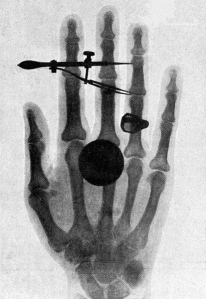A celebration of X-rays – Roentgenium

Roentgen’s X-ray image of his wife, Anna's, hand. On seeing this she exclaimed 'I have seen my death'.
On this day, 169 years ago, the man who was to receive the very first Nobel prize in physics was born. Wilhelm Conrad Röntgen, was working with a cathode ray tube when he made his discovery. He had shielded most of the tube, and found that when it was on it still caused a fluorescent effect on a plate covered with barium platinocyanide even two meters away. He named these invisible waves X-rays, indicating the unknown nature of them at the time. Roentgen, who is largely recognised as the father of diagnostic radiology, refused to take out any patents on his discoveries, and donated the money he received from his Nobel prize to his university.
In 2004, it was decided to name element 111 after Röntgen. This element had first been discovered in Germany in 1994 and its most stable isotope (Röntgenium 272) has a half-life of only 26 seconds. Writing about the crystal structure of Röntgenium is a little different to the others we've posted about, as there's never been enough of the material made to actually determine its crystal structure! It's predicted to have a body centred cubic structure, which is (as it sounds) a cubic structure of atoms with one atom sitting in the middle of these. There are a number of other elements that take up this structure, such as the alkali metals Lithium, Sodium and Potassium. Here we've pictured Potassium, which is #9008539 in the Crystallography Open Database.

Image generated by the VESTA (Visualisation for Electronic and STructual analysis) software http://jp-minerals.org/vesta/en/
But mainly we wanted to say thanks to Röntgen for discovering X-rays and making the science of diffraction and crystallography possible.






